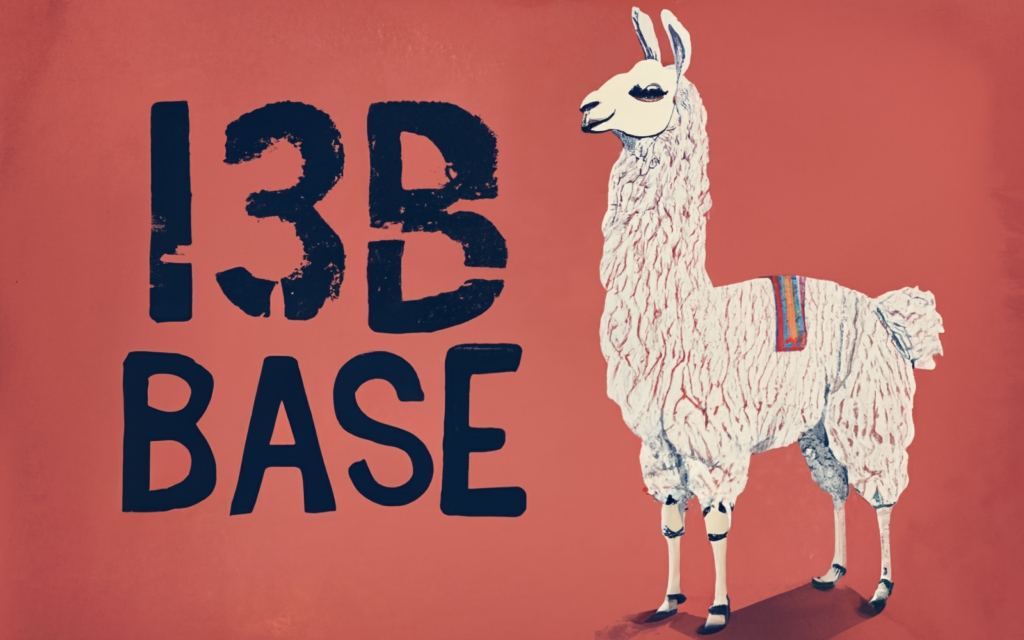llama-13b-lora
Maintainer: replicate

5

| Property | Value |
|---|---|
| Model Link | View on Replicate |
| API Spec | View on Replicate |
| Github Link | View on Github |
| Paper Link | View on Arxiv |
Get summaries of the top AI models delivered straight to your inbox:
Model overview
llama-13b-lora is a Transformers implementation of the LLaMA 13B language model, created by Replicate. It is a 13 billion parameter language model, similar to other LLaMA models like [object Object], [object Object], and [object Object]. Additionally, there are tuned versions of the LLaMA model for code completion, such as [object Object] and [object Object].
Model inputs and outputs
llama-13b-lora takes a text prompt as input and generates text as output. The model can be configured with various parameters to adjust the randomness, length, and repetition of the generated text.
Inputs
- Prompt: The text prompt to send to the Llama model.
- Max Length: The maximum number of tokens (generally 2-3 per word) to generate.
- Temperature: Adjusts the randomness of the outputs, with higher values being more random and lower values being more deterministic.
- Top P: Samples from the top p percentage of most likely tokens when decoding text, allowing the model to ignore less likely tokens.
- Repetition Penalty: Adjusts the penalty for repeated words in the generated text, with values greater than 1 discouraging repetition and values less than 1 encouraging it.
- Debug: Provides debugging output in the logs.
Outputs
- An array of generated text outputs.
Capabilities
llama-13b-lora is a large language model capable of generating human-like text on a wide range of topics. It can be used for tasks such as language modeling, text generation, question answering, and more. The model's capabilities are similar to other LLaMA models, but with the added benefits of the LORA (Low-Rank Adaptation) fine-tuning approach.
What can I use it for?
llama-13b-lora can be used for a variety of natural language processing tasks, such as:
- Generating creative content like stories, articles, or poetry
- Answering questions and providing information on a wide range of topics
- Assisting with tasks like research, analysis, and brainstorming
- Helping with language learning and translation
- Powering conversational interfaces and chatbots
Companies and individuals can potentially monetize llama-13b-lora by incorporating it into their products and services, such as Replicate's own offerings.
Things to try
With llama-13b-lora, you can experiment with different input prompts and model parameters to see how they affect the generated text. For example, you can try adjusting the temperature to create more or less random outputs, or the repetition penalty to control how much the model repeats words or phrases. Additionally, you can explore using the model for specific tasks like summarization, question answering, or creative writing to see how it performs.
This summary was produced with help from an AI and may contain inaccuracies - check out the links to read the original source documents!
Related Models

llama-7b

98
The llama-7b is a transformers implementation of the LLaMA language model, a 7 billion parameter model developed by Meta Research. Similar to other models in the LLaMA family, like the llama-2-7b, llama-2-13b, and llama-2-70b, the llama-7b model is designed for natural language processing tasks. The codellama-7b and codellama-7b-instruct models are tuned versions of LLaMA for coding and conversation. Model inputs and outputs The llama-7b model takes a text prompt as input and generates a continuation of that prompt as output. The model can be fine-tuned on specific tasks, but by default it is trained for general language modeling. Inputs prompt**: The text prompt to generate a continuation for Outputs text**: The generated continuation of the input prompt Capabilities The llama-7b model can generate coherent and fluent text on a wide range of topics. It can be used for tasks like language translation, text summarization, and content generation. The model's performance is competitive with other large language models, making it a useful tool for natural language processing applications. What can I use it for? The llama-7b model can be used for a variety of natural language processing tasks, such as text generation, language translation, and content creation. Developers can use the model to build applications that generate written content, assist with text-based tasks, or enhance language understanding capabilities. The model's open-source nature also allows for further research and experimentation. Things to try One interesting aspect of the llama-7b model is its ability to generate coherent and contextual text. Try prompting the model with the beginning of a story or essay, and see how it continues the narrative. You can also experiment with fine-tuning the model on specific domains or tasks to see how it performs on more specialized language processing challenges.
Updated Invalid Date

vicuna-13b

251
vicuna-13b is an open-source large language model (LLM) developed by Replicate. It is based on Meta's LLaMA model and has been fine-tuned on user-shared conversations from ShareGPT. According to the provided information, vicuna-13b outperforms comparable models like Stanford Alpaca, and reaches 90% of the quality of OpenAI's ChatGPT and Google Bard. Model inputs and outputs vicuna-13b is a text-based LLM that can be used to generate human-like responses to prompts. The model takes in a text prompt as input and produces a sequence of text as output. Inputs Prompt**: The text prompt that the model will use to generate a response. Seed**: A seed for the random number generator, used for reproducibility. Debug**: A boolean flag to enable debugging output. Top P**: The percentage of most likely tokens to sample from when decoding text. Temperature**: A parameter that adjusts the randomness of the model's outputs. Repetition Penalty**: A penalty applied to repeated words in the generated text. Max Length**: The maximum number of tokens to generate in the output. Outputs Output**: An array of strings representing the generated text. Capabilities vicuna-13b is capable of generating human-like responses to a wide variety of prompts, from open-ended conversations to task-oriented instructions. The model has shown strong performance in evaluations compared to other LLMs, suggesting it can be a powerful tool for applications like chatbots, content generation, and more. What can I use it for? vicuna-13b can be used for a variety of applications, such as: Developing conversational AI assistants or chatbots Generating text content like articles, stories, or product descriptions Providing task-oriented assistance, such as answering questions or providing instructions Exploring the capabilities of large language models and their potential use cases Things to try One interesting aspect of vicuna-13b is its ability to generate responses that capture the nuances and patterns of human conversation, as it was trained on real user interactions. You could try prompting the model with more open-ended or conversational prompts to see how it responds, or experiment with different parameter settings to explore the model's capabilities.
Updated Invalid Date

codellama-13b

15.3K
codellama-13b is a 13 billion parameter language model developed by Meta that is tuned for code completion. It is part of the Code Llama family of models, which also includes the codellama-7b, codellama-34b, and codellama-70b variants, as well as instruction-following versions like codellama-13b-instruct. The Code Llama models are based on the Llama 2 architecture and provide state-of-the-art performance on code-related tasks. Model inputs and outputs The codellama-13b model takes in prompts as text inputs, which can be code snippets, natural language instructions, or a combination. It then generates text outputs that continue or complete the provided input. The model supports large input contexts up to 100,000 tokens and can perform tasks like code completion, infilling, and zero-shot instruction following. Inputs Prompt**: The text input that the model will use to generate a continuation or completion. Max Tokens**: The maximum number of tokens (words or subwords) to generate in the output. Temperature**: A sampling parameter that controls the randomness of the output generation. Top K**: The number of most likely tokens to consider during sampling. Top P**: The cumulative probability threshold to use for sampling. Frequency Penalty**: A penalty applied to tokens based on their frequency of appearance. Presence Penalty**: A penalty applied to tokens based on whether they have appeared in the input. Repeat Penalty**: A penalty applied to tokens based on how many times they have appeared in the output. Outputs Output**: The generated text continuation or completion of the input prompt. Capabilities The codellama-13b model is capable of generating high-quality code completions and continuations, leveraging its understanding of programming languages and best practices. It can assist with tasks like auto-completing code snippets, generating boilerplate code, and even writing entire functions or algorithms. The model also has the ability to infill missing code segments based on the surrounding context. What can I use it for? The codellama-13b model can be used in a variety of applications that involve code generation or understanding, such as: Integrated development environment (IDE) plugins for intelligent code completion Automated code generation for prototyping or scaffolding Programming education and training tools Chatbots or virtual assistants that can help with coding tasks Augmented programming workflows to boost developer productivity Things to try Some interesting things to try with the codellama-13b model include: Providing partial code snippets and seeing how the model completes them Giving the model natural language instructions for a coding task and observing the generated code Exploring the model's ability to generate code in different programming languages or domains Evaluating the model's performance on specific coding challenges or benchmarks Experimenting with the various input parameters to see how they affect the output quality and creativity Overall, the codellama-13b model represents an exciting advancement in the field of large language models for code-related tasks, and offers a wealth of opportunities for developers, researchers, and AI enthusiasts to explore.
Updated Invalid Date

llama-2-13b

71
The llama-2-13b is a base version of the Llama 2 language model from Meta, containing 13 billion parameters. It is part of a family of Llama models that also includes the llama-2-7b, llama-2-70b, and llama-2-13b-chat models, each with different parameter sizes and specializations. Model inputs and outputs The llama-2-13b model takes in a text prompt as input and generates new text in response. The model can be used for a variety of natural language tasks, such as text generation, question answering, and language translation. Inputs Prompt**: The text prompt that the model will use to generate new text. Outputs Generated Text**: The text generated by the model in response to the input prompt. Capabilities The llama-2-13b model is capable of generating coherent and contextually relevant text on a wide range of topics. It can be used for tasks like creative writing, summarization, and even code generation. However, like other language models, it may sometimes produce biased or factually incorrect outputs. What can I use it for? The llama-2-13b model could be used in a variety of applications, such as chatbots, content creation tools, or language learning applications. Its versatility and strong performance make it a useful tool for developers and researchers working on natural language processing projects. Things to try Some interesting things to try with the llama-2-13b model include: Experimenting with different prompts and prompt engineering techniques to see how the model responds. Evaluating the model's performance on specific tasks, such as summarization or question answering, to understand its strengths and limitations. Exploring the model's ability to generate coherent and creative text across a range of genres and topics.
Updated Invalid Date